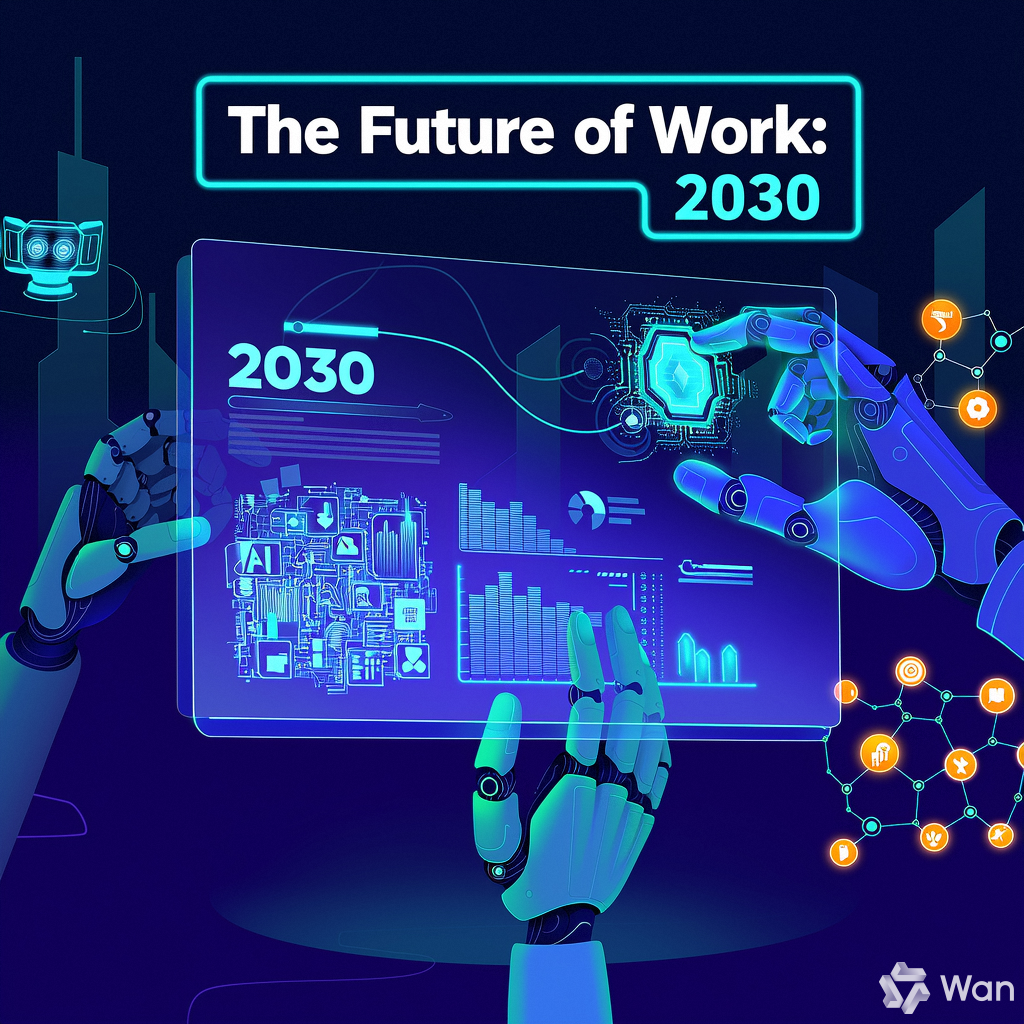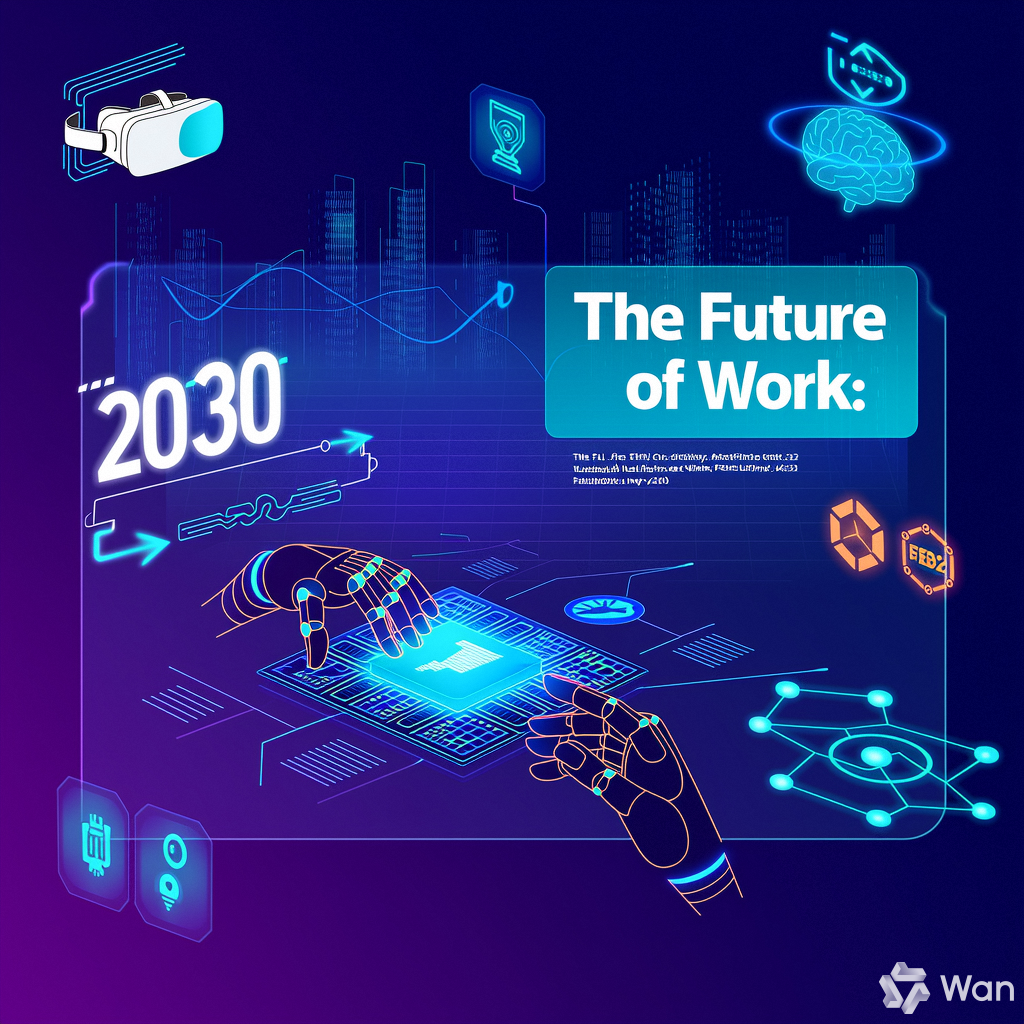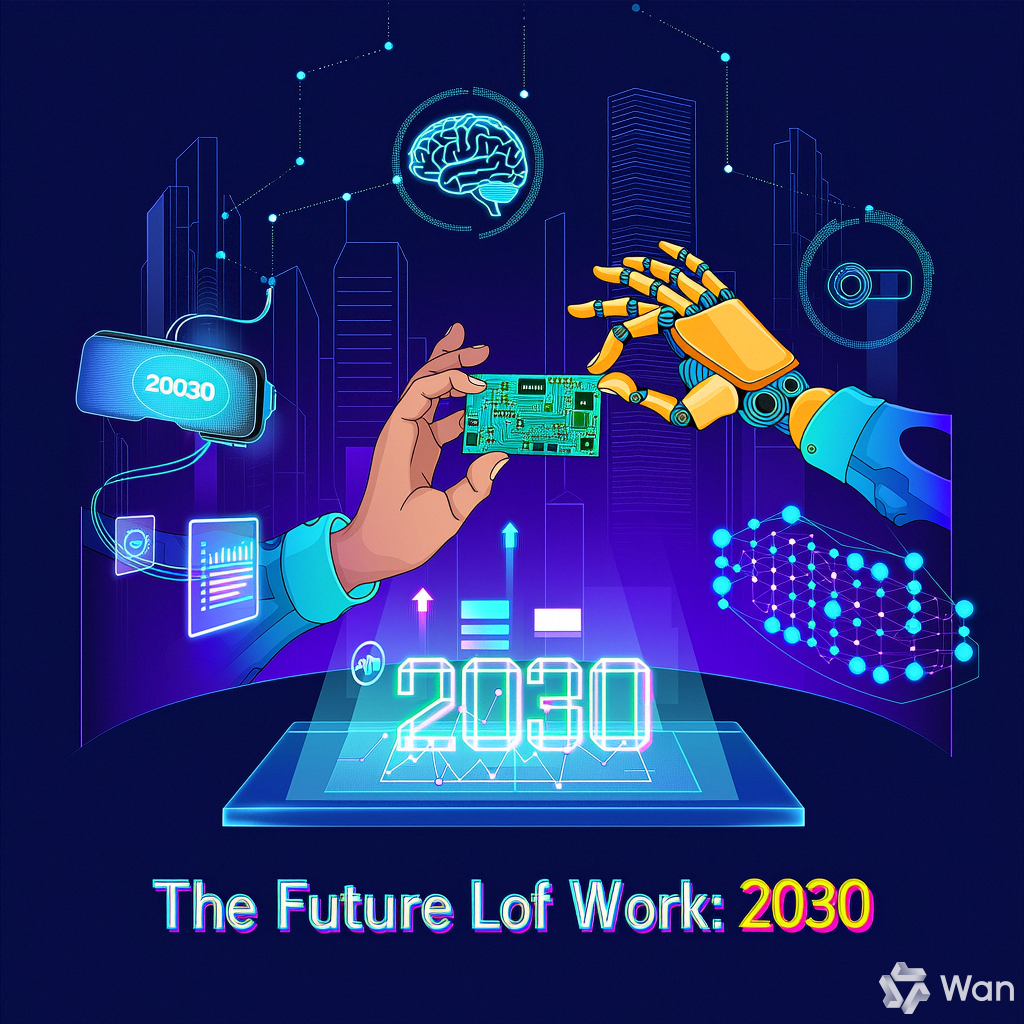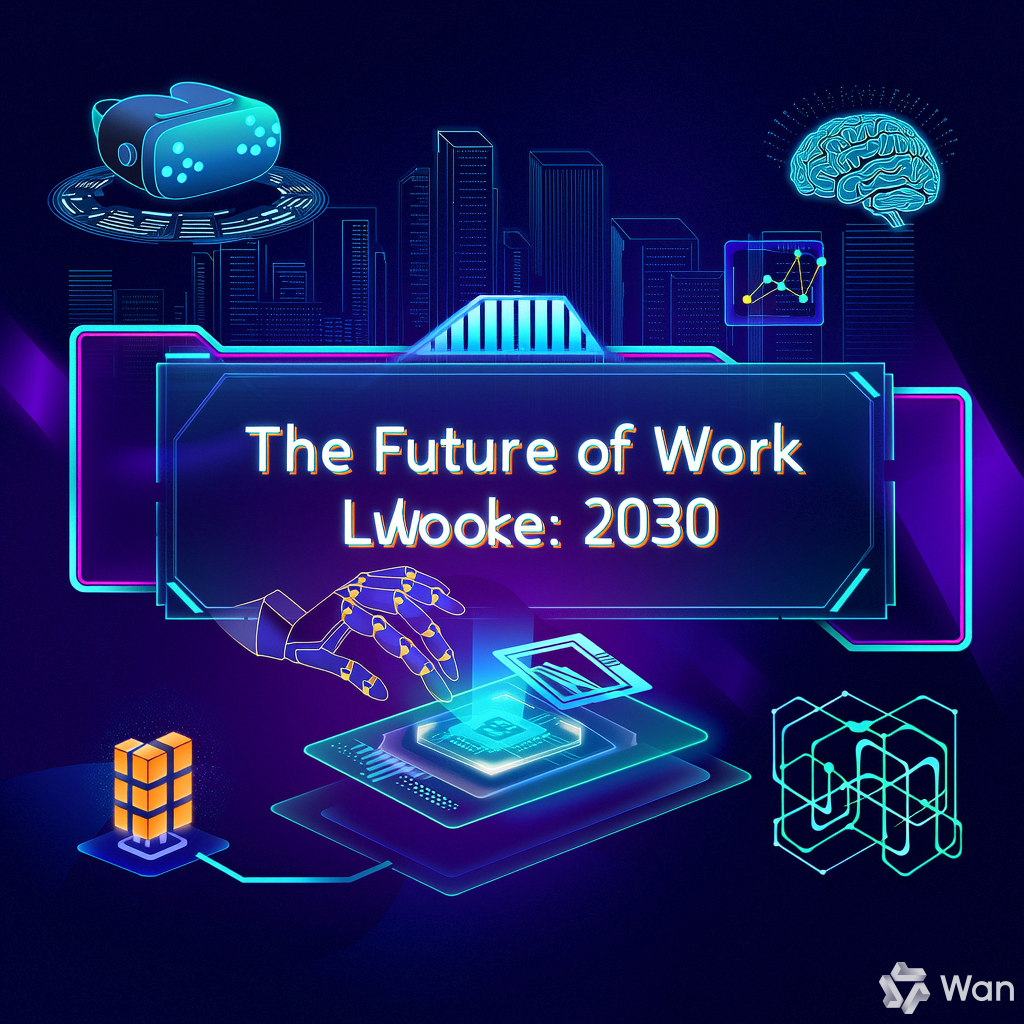The Future of Work: Technologies Reshaping the Job Market by 2030
The Future of Work: Technologies Reshaping the Job Market by 2030

The Future of Work: Technologies Reshaping the Job Market by 2030

Amidst an era of unparalleled technological progress, the world of work is changing at a dizzying rate. The Future of Work By 2030, the world of work as we know it will experience a fundamental transformation, as disruptive technologies that already are and will continue to revolutionize industries, occupations, and the nature of work itself.
The future of work is not an evolution, but a revolution a revolution that holds out both unprecedented opportunities and major challenges to workers, employers, policymakers, and educators. This foundational question examines the major technologies that will transform the world of work by 2030, charting how individuals and institutions can prepare and succeed in this new world of work.
Artificial Intelligence and Automation: The New Workforce Dynamic
The introduction of artificial intelligence (AI) and automation technologies into the labor force is arguably the most important change in the future of work landscape. Sophisticated AI machines are no longer limited to doing routine, repetitive work but are now able to carry out intricate cognitive work that was heretofore assumed to be the sole preserve of human labor. Machine learning algorithms now exhibit remarkable proficiency in pattern recognition, decision-making, and even creative problem-solving.
The Future of Work By 2030, AI-powered automation will have changed many industries, including manufacturing and logistics, healthcare, and finance. Though some anticipate overall job displacement, the past offers a different story: technological disruption has usually stopped specific jobs in their tracks while at the same time inventing new types of work. The revolutionary twist in The Future of Work technological revolution is its unprecedented speed and magnitude, which requires workers to make adaptability and tech savviness core competencies. Organizations that successfully integrate human-AI collaboration frameworks—leveraging AI for data-intensive tasks while taking advantage of uniquely human capabilities like emotional intelligence, ethical decision-making, and innovative thinking—will achieve deep competitive advantages in the market of tomorrow.
Remote Work Technologies: The Distributed Workforce Revolution
The global pandemic of 2020 dramatically accelerated the adoption of remote The Future of Work technologies, fundamentally altering perceptions about where and how work can be performed. The Future of Work By 2030, this shift will have matured into a sophisticated ecosystem of digital collaboration tools, virtual reality meeting spaces, and advanced telecommunications infrastructure that enables truly seamless distributed work. The traditional office will not disappear but will be reimagined as one node in a broader network of workspaces, including homes, co-working facilities, and entirely virtual environments.
This geographical uncoupling of talent from workplace represents a profound disruption to labor markets worldwide. Organizations will gain access to global talent pools, while workers will enjoy unprecedented flexibility and geographic mobility. However, this distributed model also introduces complex challenges related to team cohesion, organizational culture, and work-life boundaries.
The most successful companies of 2030 will be those that develop nuanced approaches to remote work— The Future of Work implementing thoughtful policies and leveraging cutting-edge technologies that preserve human connection while maximizing the benefits of location independence. Furthermore, this paradigm shift will trigger ripple effects across urban planning, real estate, transportation, and environmental sustainability as work patterns and population distribution evolve in response to these new technological capabilities.
Internet of Things and Smart Infrastructure: Creating Interconnected Workplaces

The development of Internet of Things (IoT) technology will transform physical workplaces into responsive, intelligent spaces The Future of Work in 2030. Advanced sensor networks, data analysis software, and automation systems will converge to create workplaces that continuously adapt to human requirements and operational needs.
From intelligent buildings that maximize environmental conditions for comfort and productivity to networked industrial equipment that foresees maintenance requirements prior to failure, IoT technologies will revolutionize the way we interact with our working environments.
This networked infrastructure will produce unprecedented amounts of operational data, allowing organizations to make data–driven decisions regarding workplace design, resource allocation, and process optimization. Facility managers will be transformed into data strategists who leverage IoT-generated insights to create workplaces that optimize collaboration, creativity, and efficiency. At the same time, employees will interact with smarter tools and environments that predict needs and optimize workflows. Yet The Future of Work this transformation also poses pressing questions about privacy, surveillance, and the mental health effects of perpetual connectivity. Effective implementation will demand careful governance structures that weigh efficiency gains against ethical concerns for worker agency and data ownership. The incorporation of IoT technologies will also drive sustainability efforts, with intelligent systems streamlining energy consumption, minimizing waste, and minimizing environmental footprint. Carbon-neutral or carbon-negative operations will be both technically viable and economically appealing by 2030 for progressive organizations, leading to widespread adoption of green technologies across the workplace.
Augmented and Virtual Reality: Transforming Skills Development and Collaboration
The Future of Work By 2030, augmented reality (AR) and virtual reality (VR) technologies will have extended beyond their origins in gaming and entertainment into essential tools in the workplace. These immersive technologies will change the way employees learn, collaborate, and perform intricate tasks in almost every sector.
Advanced AR interfaces will superimpose digital data on the physical environment, allowing employees to tap into real-time advice, The Future of Work animate intricate data, and manipulate digital objects in three-dimensional space. At the same time, VR spaces will offer immersive simulation capabilities that revolutionize training, design workflows, and remote collaboration.
In medicine, manufacturing, and every sector in between, AR-assisted work will be the norm.
Surgeons will operate with critical patient data projected onto their field of vision, and assembly line workers will be provided with visual, step-by-step instructions for complicated assembly procedures. The technologies will radically shorten learning curves, minimize errors, and facilitate real-time performance improvement.
Similarly, VR training simulations will allow workers to gain hands-on experience in high-risk or low-frequency scenarios without physical danger or resource constraints, fundamentally changing the way workforce competencies are developed and maintained.
Most revolutionary, perhaps, are the ways that mixed reality technologies will reshape collaboration for the distributed workforce. Virtual meeting spaces will move beyond video-only interfaces to become spaces where groups can engage with shared digital artifacts, receive nonverbal communication cues, and achieve states of engagement previously impossible outside of copresence. In so doing, this will dissolve the distinction between copresent and remote work, introducing new models of team and organizational dynamics that transcend geographical limitations without compromising human connection.
Blockchain and Decentralized Work Platforms: Reimagining Employment Models

Blockchain technology and its use in decentralized systems will radically change labor markets and work arrangements by 2030. Beyond cryptocurrency uses, blockchain will make possible new organizational models of work by rendering economic relations secure, transparent, and programmable. Smart contracts—self-executing contracts with the rules directly written into software code—will commoditize complex business processes and allow for new types of decentralized collaboration that don’t rely on conventional corporate hierarchies. The future will see the rise of decentralized autonomous organizations (DAOs) that will transform traditional employment models, developing fluid frameworks in which employees engage in various projects concurrently, with compensation, decision-making powers, and reputation being handled through blockchain-based systems.
This transition will fuel the already expanding contingent workforce movement, making labor markets more balanced and open in which value creation is more closely connected to reward. For workers, this transformation promises greater autonomy and multiple sources of income; for companies, it offers unprecedented flexibility in staffing teams to address individual project demands.
Additionally, blockchain technology will disrupt credential verification and skills measurement, generating tamper-proof records of education, work history, and demonstrated abilities. This will decrease hiring friction and allow for more accurate matching between skill and opportunity. Yet these decentralized systems also pose complicated regulatory and social protection issues, necessitating innovative policy responses to uphold economic security in the context of a changing fluid labor market.
The societies that will thrive the most will be those that evolve flexible legal frameworks and social protection systems to fit these new work patterns without abandoning fundamental protections for workers.
The Human Element: Skills and Capabilities for 2030

As technological change transforms the employment landscape by 2030, human skills will continue to be paramount but will need to be substantially enhanced. Being able to collaborate with high-end AI systems—knowing their strengths, their weaknesses, and their best uses—will become a foundational skill in the majority of workplaces and job categories. This man-machine collaboration will require not only technical proficiency but also high-level judgment regarding when and where to apply technological tools.
The accelerating rate of technological innovation will render continuous learning and agility the greatest career success factors. Conventional front-loaded knowledge acquisition education systems will be replaced by lifelong learning frameworks supported by microlearning platforms, AI-driven individualized education, and experiential skills acquisition technologies. Employees will create personalized learning tracks that integrate formal certification with demonstrations of ability, project portfolios, and peer recognition systems.
Organizations will move away from employing chiefly on the basis of current capability but choose individuals with high potential for learning agility and adaptability.
Most of all, perhaps, are characteristically human skills that will be most in demand in the 2030 workforce. As more and more routine physical and cognitive labor is automatized, employees with skills such as creative problem-solving, ethical decision-making, emotional intelligence, and cross-cultural communication will be singular assets. Being able to manage complexity, juggle competing priorities, and make sense out of ambiguous information will be essential in an era when linear challenges are ever more resolved by machines.
This fact will require education systems to do more than the distribution of information in order to address these quintessentially human abilities, and organizational cultures will need to create climates in which creativity, empathy, and wisdom are valued and celebrated as the core of long-term success.
Conclusion: Navigating the Future of Work
The technological forces reshaping the employment landscape by 2030 The Future of Work hold both great opportunity and existential threat. Artificial intelligence, remote collaboration tools, IoT networks, immersive reality, and blockchain platforms will intersect to create a work environment that is vastly different from the current paradigm. Organizations and individuals who stay ahead of these changes—developing adaptive strategies, investing in relevant skills, and reinventing traditional structures—will thrive in this new reality.
The shape of future work will not be determined by technological possibility but by human decisions regarding how these technologies are introduced, governed, and absorbed into our economic and social systems. Policymakers, schools, business leaders, and workers themselves will need to take collective action if technological advancement is to deliver shared prosperity at scale instead of mounting inequality.
Looking forward to 2030, the optimal path forward will be a synthesis of technological advancement and human-centered design, developing work environments that enhance the strengths of humans instead of merely displacing them. By placing characteristically human capabilities first and augmenting them with the strength of emerging technologies, we can shape a future of work that provides dignified opportunity, increases productivity, and leads to individual and collective thriving.
Frequently Asked Questions About the Future of Work
What jobs will disappear by 2030 due to automation?
Although predictions differ, jobs with highly routine, predictable work are most susceptible to automation. These range from data processing jobs, simple accounting, assembly line production, and some customer service tasks. But rather than outright job displacement, radical role change is more plausible, with humans doing more of the parts involving judgment, creativity, and people skills as routine elements get automated.
Which industries will experience the most growth by 2030?
Industries that sit at the confluence of new technologies and human needs will see phenomenal growth. These would be healthcare technology, renewable energy, cybersecurity, data analytics, artificial intelligence research, digital content creation, and personalized education. New industries will also arise around technologies such as extended reality, advanced robotics, and synthetic biology.
How can workers prepare for the changing job market?
Preparation strategies encompass: building technology fluency alongside uniquely human skills such as creativity and emotional intelligence; maintaining a lifelong learning mindset with occasional skills rejuvenation; building flexibility and resilience through varied experiences; developing cross-disciplinary knowledge instead of specialized training; and keeping abreast of advances in your area and watching for transferable skills that may apply to new arenas.
Will remote work continue to expand The Future of Work through 2030?
Yes, remote and hybrid work arrangements will further grow, but with considerable variation by industry and job. The most probable result is a range of arrangements crafted to suit the particular job and organizational requirements. Technological advances in virtual teamwork, immersive communication, and cybersecurity will increasingly eliminate the existing obstacles to distributed work, and physical workplaces will be revamped to focus on experiences that are challenging or impossible to duplicate virtually.
How will education systems change to prepare workers for 2030?
Change in education will include: greater emphasis on flexibility and learning to learn; integration of AI-powered personalized learning pathways; greater direct contact between education institutions and industry; spread of micro-credentials and competency-based certification; greater emphasis on distinctively human skills alongside technical knowledge; and normalization of continuous learning throughout working life rather than being concentrated in early adulthood.
What government policies might help address workforce transitions?
.